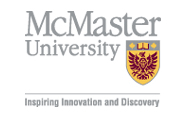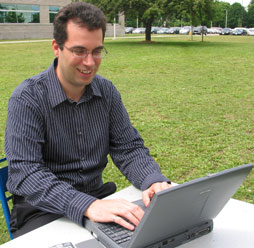The message is in the light
McMaster engineer on the cutting-edge of wireless communications technology
by Graham Jansz - SPARK writer
June 27, 2005
According to Homer's Iliad, in the 13th century BC fire beacons were used to signal the Grecian siege of Troy. Samuel Morse made history around 1843 with the development of the first long-distance electric telegraph. In 1880, Alexander Graham Bell and Charles Tainter patented their photophone, which used light to transmit a voice signal over 200 meters. In 1902, Marconi transmitted a radio signal across the Atlantic Ocean and in 1925 the first television signal was broadcasted. By 1979 the first cell-phone network was developing in Japan, 65 years after the first cross-continental telephone call. In 1994, the internet entered the public domain, and by 1996 a modem was developed that allowed data to be transferred at a rate of 56,000 bits per second. Today, you can sit on a bench outside the McMaster University Student Centre and download information about the history of communications hundreds of times faster than 10 years ago - and you can do it without a single wire.
Human beings have an innate desire to communicate with each other. Throughout the history of civilization, huge leaps and bounds have been made towards increasing the speed, distance, quality and efficiency of this communication. McMaster's Steve Hranilovic is working at the frontier of this ongoing trend of technological advancement.
Hranilovic, an assistant professor in the Department of Electrical & Computer Engineering, studies data communications. Specifically, he studies how light waves can be used as a medium for wireless data communication - a field also known as wireless optical communications.
Wireless communication technologies use electromagnetic (EM) waves to transmit data. The properties of EM waves can be pictured by imagining ocean waves. The wavelength is the distance between the top of one wave and the top of the next. Frequency is the number of waves that pass through a certain point in a specific amount of time. The different types of EM waves have different wavelengths and frequencies; such types include radio waves, microwaves, infrared light, visible light, ultraviolet light, x-rays and gamma rays.
Current wireless technologies, like those used in laptop computers, involve transmitting data through radio waves; these radio waves are similar to the ones that carry the signals that stereos pick up and convert to sound. Radio waves have a wavelength around one tenth of a meter to one meter. In contrast, Hranilovic is focusing on light that has a wavelength of around 850 to 900 billionths of a meter.
Because optical communications waves have a small wavelength, they cannot travel though walls like their radio counterparts. This property causes the waves containing the signal to reflect off objects and reach most areas of a room. The inability to travel through walls also has important implications for security. Making data transmission secure when using optical communications is as simple as shutting the door and closing the blinds.
Wireless optical communications can also be extremely fast. Because the waves Hranilovic uses are so small, many more waves reach a receiver each second. This means that a great deal of information can be transferred in a very small amount of time.
To be able to transmit information through a wave, the information must be MOdulated into the wave and then DEModulated out of the wave back into information; this is what modems do (hence their name). Through funding from the Natural Sciences and Engineering Council (NSERC), Hranilovic has not only been able to conceive the design for optical modems, he has been able to build prototype models.
Hranilovic emphasizes the importance of physically demonstrating theoretical ideas through prototype designs. "The devil's in the details - writing it down on paper or having a nice simulation on the computer only gives you so much of the story. Once you start trying to make the thing usable, you run into a lot of implementation challenges." Using prototypes allows Hranilovic to advance his research by determining which theories will actually lead to practical uses. It also allows his students to "gain a nice breath of knowledge, and get [their] hands dirty."
Hranilovic also hopes to give a very literal meaning to the clichéd phrase, "a picture's worth a thousand words." When we see pictures, our eyes are receiving many waves of light grouped together and our brains are converting this grouping of light into an image.
Hranilovic reasons that if single waves of light can be used to transmit data, several waves of light grouped together should transmit data even more efficiently. Hranilovic hopes to develop methods of transmitting data through many waves of light grouped together. He is also aiming to build digital "eyes" and "brains" that could receive this grouped light and covert it into data. The result of this work would be extremely fast communication - billions of bits per second.
The applications of work like that of Hranilovic are vast and far-reaching - literally. Wireless optical communications technologies are being incorporated into satellites, probes and space stations. It has also been proposed that they be used for communications between different components of computers. Optical communications may become widespread in metropolitan areas where radio interference is common. They may also play unique roles in situations where radio communication cannot be used safely such as hospitals, airplanes and factories using explosive gases.
The usefulness of the technologies that Hranilovic is working to develop seems to be limited only by the creativity of the developers. With this in mind, one can rest assured that the historical trend of innovation in communications will continue to be pushed forward by the likes of Steve Hranilovic. Perhaps one day you will be able to enter a room, point your computer at the wall, connect to the internet and instantly learn that, in the twenty-first century, researchers from McMaster University spearheaded the next major advancement of wireless communications technology.
(The Natural Sciences and Engineering Research Council SPARK (Students Promoting Awareness of Research Knowledge) program was launched in 1999 at 10 universities across Canada. Through SPARK, students with an aptitude for communications are recruited, trained and paid to write stories based on the NSERC supported research at participating universities.)



